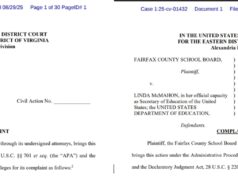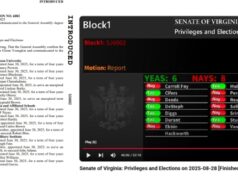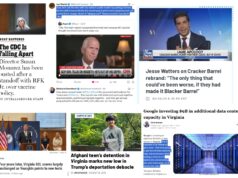I had a chance Thursday to catch up with Virginia Secretary of Education Atif Qarni, who has been very busy the past year, and who (not surprisingly, given all that’s been going on) had a lot of ground to cover in our conversation. So, I’m going to break this interview up into two parts. See below for the interview, with highlights in blue/bold, from part 1 of our conversation, on what the major accomplishments in education have been the first three years of the Northam administration; dealing with the COVID-19 crisis; Republicans’ “irresponsible” demands for an immediate return to five-days-a-week in-person learning; plans to get kids back to full-time, in-person learning this fall; etc.
Question: Why don’t we just start with an overview? You’re now in your final year as Secretary of Education; what would you say your top accomplishments have been and what do you feel still needs to get done in the remaining nine months or so?
Qarni: Expanding early childhood education to get more under-served three and four-year-olds access into high-quality early childhood settings. There are about 510,000 total children age 0-5 in VA. 182,325 (36%) of them live in low-income households. 33,699 (7%) qualify for special education or early intervention. About 68,000 children age 0-5 were served by state, federal, and local funds in 2020.
- VPI – 18,537
- Federal child care subsidy program (CCSP) 23,153 (this fund moves to VDOE July 1, 2021)
- Early Childhood Special Education (ECSE) 9,033
- Head Start 16,591
- Mixed Delivery 246
Our goal is to add roughly 20,000 children to this count over the next five years to ensure all at-risk three and four-year-olds have access to quality early learning. The Governor’s introduced budget, combined with the 40% of dedicated revenue in the marijuana legislation bills will help us reach that goal.
Also, HB 2206 (Filler-Corn) has the potential to add an additional several thousand children to this list temporarily using federal stimulus dollars from 2021-2022.
Note: All of the publicly funded programs listed above are currently housed in different agencies and secretariats. By July 1, 2021, they will all be managed by the Office of Early Childhood at the VDOE, thanks to Governor’s bills SB578/HB1012 in 2020.
In the K-12 space, there have been numerous initiatives…The administration, in partnership with the General Assembly, the Governor has done a 10% salary increase for teachers and staff over the past three years. Another big accomplishment in the K-12 space is that there has been a shift from a culture of high-stakes testing to a culture that’s focused on deeper learning and project-based learning, and a culture that’s focused on social-emotional support, social-emotional learning. One of the components of that was getting more school counselors in our schools. We now can fund 1 counselor for every 325 students. We’re not at the gold standard yet but we made significant progress. What that effort did was it opened up opportunities to have deeper conversations on support positions in general – social workers, psychologists, school nurses. The Board of Education recommended that there should be four support personnel for about a thousand children, and those support personnel include things like social workers, psychologists, nurses, and so forth. Now, we’re going to be able to fund three for a thousand. Where Virginia really needs to go in the next frontier is to really look at what are the gold standards for support positions. The Board of Education made strides in the 2019 Standards of Quality. We as a state need to stay at it.
One last area I want to highlight is that we moved mountains in creating a culturally responsive school environment. We’ve revamped our history and social studies standards to establish an African-American history education commission that looked at all of our standards for K-12 history and social studies. We have started the process of revamping and teaching a more inclusive and complete history. There was a historic bill that was passed which:
Requires teacher, principal, and division superintendent evaluations to include an evaluation of cultural competency. The bill requires every person seeking initial licensure or renewal of a license from the Board of Education (i) to complete instruction or training in cultural competency and (ii) with an endorsement in history and social sciences to complete instruction in African American history, as prescribed by the Board. The bill also requires each school board to adopt and implement policies that require each teacher and any other school board employee holding a license issued by the Board to complete cultural competency training, in accordance with guidance issued by the Board, at least every two years. Locke SB1196, Jenkins HB1904
We also established a culturally advisory committee to make sure we make our curriculums and school more culturally responsive for all various groups like Jewish Americans, Muslims, AAPI Latinx, LGBTQ, Indigenous, etc. It’s a group of about 30 members representing all of the different diasporas that exist. The group includes historians and experts in these fields who are going to look at history and social studies standards, they’re going to look at our curriculum, they’re going to look at professional development. This work will be ongoing and they’re going to continue to enhance and improve and revamp what is taught in schools. I’m just really proud of these milestones. It’s going to make our future generations more empathetic and thoughtful.
Then in the higher education space, the biggest accomplishment is obviously the implementation of a tuition-free community college – G3. The focus is on high-need areas like health sciences, technology, and trades. Our model is awesome. It’s a stackable credential model, where you can start this in high school through dual enrollment classes, where a student can get college credit. We’re strengthening these agreements between high schools and community colleges…we are strengthening our agreements between our community colleges and our university so those credits can transfer over. The community college model is cutting edge. One big component of this model is that a student who has enrolled full-time with a certain GPA at the beginning of the semester can get a stipend of a thousand dollars to pay for different things like food, housing, childcare. Many students who are going to community college struggle to finish due to these insecurities. This wrap-around package is going to help many students get their credentials and get a high-quality job.
We were able to get in-state tuition rates for undocumented students last year and state financial aid for undocumented students this year. We also increased need-based financial aid almost doubled it in the last three years. We invested $300 million in our two public HBCUs, the largest investment in Virginia’s history in our HBCUs. We established a talent fund for the next decade, which is going to create an enormous amount of opportunities for students in computer science.
Question: On COVID, Republicans have been complaining that we haven’t quite reopened schools uh quickly enough and the statewide candidates but most of them are the republicans are demanding five days a week in-person instruction now I mean how do you respond to those people?
Qarni: We have prioritized safety. When the governor closed down schools on March 13th of 2020, it was a very tough decision. But we didn’t know anything about the pandemic and we had to close things down, take a step back to see where is the pandemic going, and then gradually think about how to shift. Our school division shifted right away. They shifted to a virtual format. April through June we worked actively by convening a COVID task force that included stakeholders from early childhood, K-12, and higher education and public and private. It was a massive task force that focused on four key areas – addressing the digital divide, learning gaps, bio-psycho-social needs, and basic needs. Through the work of localities and state, we were able to serve nearly a quarter-million meals every day. Essentially all of our children were provided a device of their own and we created a learning management system so all content can be accessed virtually. When the new academic year began, local divisions made different choices. Some were able to bring in more students in person, some used a hybrid approach and some stayed fully remote. Since the beginning of this academic year, we have tracked what each division has done. Here is the link: https://doe.virginia.
Question: But now, Republicans are making this a big political issue, that supposedly schools should be totally open right now…
Qarni: We take a lot of hits because the pandemic has been politicized. However, we are listening to basing our decisions on the facts and science. COVID is not a hoax, it’s a very serious pandemic, and we have had to navigate through the last 13 months thoughtfully in the face of misinformation and gaslighting and a lot of hostility. When the time was right, the Governor put a marker down of March 15th to set an expectation to have all 132 school divisions submit a plan for in-person. Every single division responded. Things are moving in the right direction. The Governor, First Lady, and I are traveling all over the state and I’m seeing things move across the state. There’s a lot of gaslighting that’s happening in politics, especially Republicans. I get it, it’s an election year. However, misinformation and gaslighting are harmful and unfortunate. I’m optimistic that as the next academic year begins all children will have the option to be back five days a week in person because we are getting control of the pandemic, vaccination is really going well, and our mitigation efforts have continued to improve.
Question: You’re saying we’ll definitely have five days a week by the fall?
Qarni: Absolutely. The vaccinations are going well. According to our recent numbers…our best estimates show us that 83 percent of our school personnel have had access to a vaccine. And we believe that by the end of March, it’s very realistic that every single person working in a school building will have had access to a vaccine if they want it. Our best estimates show that 67% of our school personnel – teachers and staff – have reported to us that they have had their first dose and 44% have reported that they’ve had both doses. Even though vaccination is not part of our reopening plan for in-person, it puts people at ease, it does make things easier. Also, we shouldn’t just give up on this academic year, we’ve still got three months, we need to continue to bring as many kids back in person and safely, with all the mitigation strategies. We need to get creative. We’re not going to mandate it, but with the federal dollars that are coming in, with the state dollars that are in the budget, we have a lot of resources allocated, and I want to encourage schools to utilize these resources to do extended learning, whether it’s Saturday school, whether they want to do summer school. I want to encourage looking at year-round models and getting creative. Year-round doesn’t mean that you’re doing more school days, you’re just being more creative. You take the 180 days that are required by the federal government and you restructure them and get creative…Be creative, be nimble, be agile…the resources are there…
With the first CARES package, Virginia K-12 schools received $238,599,192. In the second CARES package, Virginia got another $939,280,578. And with the American Rescue Plan, our K-12 will receive $2,109,491,000. With the first CARES package, our higher education received $294,391,162, in the second CARES package $521,097,535 and with the American Rescue Plan, our higher-ed will receive $845,854,000. If we use the federal funds and the state dollars effectively the next few years, we will have the resources needed to use for mitigation, address digital needs, address social-emotional needs, address food insecurity, but most important really focus on closing learning gaps exacerbated by the pandemic.














![Monday News: Trump’s Lunacy Pushes China, Russia, India, etc. Together; “Happy Labor Day. Donald Trump and Elon Musk Are Screwing Workers.”; “Where is the [media’s] intense focus on Trump’s failing health?”; ““Trump says he is not a dictator. Isn’t he?”](https://bluevirginia.us/wp-content/uploads/2025/09/montage0901-100x75.jpg)